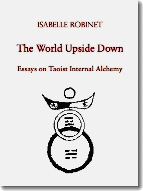"Reversal" in Internal Alchemy
Isabelle Robinet
Reproduced from:
The World Upside Down: Essays on Taoist Internal Alchemy
Isabelle Robinet
Golden Elixir Press, 2011
Paperback ● Kindle ● PDF
Four essays on Taoist Internal Alchemy translated for the first time into English. Their subjects are: (1) The alchemical principle of "inversion"; (2) The devices used by the alchemists to "manifest the authentic and absolute Dao"; (3) The role of numbers in Taoism and in Internal Alchemy; (4) The meanings of the terms "External Elixir" and "Internal Elixir". Read more on this book.
Internal Alchemy, or Neidan, is a technique of enlightenment whose earliest extant written records date from the 8th century. It appeals both to rationality, which gives order to the world, and to what transcends rationality: the unspeakable, the Totality. Its main tools are the trigrams of the Yijing (Book of Changes) and a number of key metaphors, some of which are alchemical in nature, whence the name, "Internal Alchemy."
Alchemy begins with a binary structure made of two complementary and antagonistic terms: pure Yin and pure Yang. However, their binary structure admits complexity with two other mixed terms, born from the union of the first two: Yin containing Yang, and Yang containing Yin. A neutral term, the Center, is beyond the conjunction and the disjunction of the other two.
Articles by Isabelle Robinet
● Yin and Yang in Internal Alchemy
● "Reversal" in Internal Alchemy
● The Language of Internal Alchemy
Related pages
The principle consists in ordering the world by means of multiple and complex reference points built on the basis of these initial data and of a multi-layered structure. Here lies the rationality of alchemy, in the sense of providing order and intelligibility. However, being a didactic technique oriented toward mysticism, alchemy also involves the denial of its own system. This denial is achieved by several means: the reminder that silence is the foundation of the word; the continuous evocation of Unity, which merges and abolishes all reference points; the adoption of a fundamentally metaphoric language that must be surpassed; the continuous disruptions in the continuity of discourse; the use of images that play at several levels and operate in one direction and in the opposite direction, and are related to one another until they are all unified; the ellipsis that handles two different entities as equivalent; the reciprocal encasement of all images, so that "the child generates its mother" and the contained is the container; the multiplicity of facets, times, and reference points superimposed above another, which counteracts the fragmentation wrought by rational analysis.
Therefore the alchemists use a highly structured language, but transgress it by introducing a negation of their own system, and by expressing, through a system of reciprocal encasements, a duality absorbed into Unity, a rationality traversed by irrationality. The language of alchemy is a language that attempts to say the contradictory.
One facet of this system is the theme of the "world upside down."
Look at the gate of death as the gate of life,
Do not take the gate of life to be the gate of death.
The one who knows the mechanism of death and sees the reversal
Begins to understand that the good is born within the evil.
(Wuzhen pian, "Jueju," poem no. 62.)
The Sun at the West, the Moon at the East. Heaven is Earth, Earth is Heaven. This symbolizes the growth and union of Yin and Yang, the reversal [of the course] of the five agents. (Ziyang zhenren wuzhen pian zhushu, 8.13b)
"Reversal" (diandao) is one of the basic principles of Internal Alchemy. This principle takes many forms and is applied in different ways. To obtain the Golden Elixir — the equivalent of the Philosopher's Stone — one should go through several reversals. According to a sentence often quoted in the texts, "Those who go in the ordinary sense give birth to human beings; those who go backward find immortality."
© Golden Elixir Press 2023















